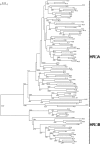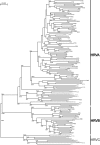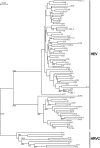A diverse group of previously unrecognized human rhinoviruses are common causes of respiratory illnesses in infants
- PMID: 17912345
- PMCID: PMC1989136
- DOI: 10.1371/journal.pone.0000966
A diverse group of previously unrecognized human rhinoviruses are common causes of respiratory illnesses in infants
Abstract
Background: Human rhinoviruses (HRVs) are the most prevalent human pathogens, and consist of 101 serotypes that are classified into groups A and B according to sequence variations. HRV infections cause a wide spectrum of clinical outcomes ranging from asymptomatic infection to severe lower respiratory symptoms. Defining the role of specific strains in various HRV illnesses has been difficult because traditional serology, which requires viral culture and neutralization tests using 101 serotype-specific antisera, is insensitive and laborious.
Methods and findings: To directly type HRVs in nasal secretions of infants with frequent respiratory illnesses, we developed a sensitive molecular typing assay based on phylogenetic comparisons of a 260-bp variable sequence in the 5' noncoding region with homologous sequences of the 101 known serotypes. Nasal samples from 26 infants were first tested with a multiplex PCR assay for respiratory viruses, and HRV was the most common virus found (108 of 181 samples). Typing was completed for 101 samples and 103 HRVs were identified. Surprisingly, 54 (52.4%) HRVs did not match any of the known serotypes and had 12-35% nucleotide divergence from the nearest reference HRVs. Of these novel viruses, 9 strains (17 HRVs) segregated from HRVA, HRVB and human enterovirus into a distinct genetic group ("C"). None of these new strains could be cultured in traditional cell lines.
Conclusions: By molecular analysis, over 50% of HRV detected in sick infants were previously unrecognized strains, including 9 strains that may represent a new HRV group. These findings indicate that the number of HRV strains is considerably larger than the 101 serotypes identified with traditional diagnostic techniques, and provide evidence of a new HRV group.
Conflict of interest statement
Figures





References
-
- Rueckert RR. Picornavirus structure and multiplication. In: Fields BN, Knipe DM, Howley PM, editors. Virology. 3rd ed. New York, N.Y.: Raven Press, Ltd; 1996. pp. 609–654.
-
- Pelon W, Mogabgab WJ, Phillips IA, Pierce WE. A cytopathogenic agent isolated from naval recruits with mild respiratory illnesses. Proc Soc Exp Biol Med. 1957;94:262–267. - PubMed
-
- Kapikian AZ, Conant RM, Hamparian VV, Chanock RM, Dick EC, et al. A collaborative report: rhinoviruses–extension of the numbering system. Virology. 1971;43:524–526. - PubMed
-
- Kapikian AZ, Conant RM, Hamparian VV, Chanock RM, Chapple PJ, et al. Rhinoviruses: a numbering system. Nature. 1967;213:761–762. - PubMed
Publication types
MeSH terms
Substances
Associated data
- Actions
- Actions
- Actions
- Actions
- Actions
- Actions
- Actions
- Actions
- Actions
- Actions
- Actions
- Actions
- Actions
- Actions
- Actions
- Actions
- Actions
- Actions
- Actions
- Actions
- Actions
- Actions
- Actions
- Actions
- Actions
- Actions
- Actions
- Actions
- Actions
- Actions
- Actions
- Actions
- Actions
- Actions
- Actions
- Actions
- Actions
- Actions
- Actions
- Actions
- Actions
- Actions
- Actions
- Actions
- Actions
- Actions
- Actions
- Actions
- Actions
- Actions
- Actions
- Actions
- Actions
- Actions
- Actions
- Actions
- Actions
- Actions
- Actions
- Actions
- Actions
- Actions
- Actions
- Actions
- Actions
- Actions
- Actions
- Actions
- Actions
- Actions
- Actions
- Actions
- Actions
- Actions
- Actions
- Actions
- Actions
- Actions
- Actions
- Actions
- Actions
- Actions
- Actions
- Actions
- Actions
- Actions
- Actions
- Actions
- Actions
- Actions
- Actions
- Actions
- Actions
- Actions
- Actions
- Actions
- Actions
- Actions
- Actions
- Actions
- Actions
- Actions
- Actions
- Actions
- Actions
- Actions
- Actions
- Actions
- Actions
- Actions
- Actions
- Actions
- Actions
- Actions
- Actions
- Actions
- Actions
- Actions
- Actions
- Actions
- Actions
- Actions
- Actions
- Actions
- Actions
- Actions
- Actions
Grants and funding
LinkOut - more resources
Full Text Sources
Other Literature Sources
Medical

